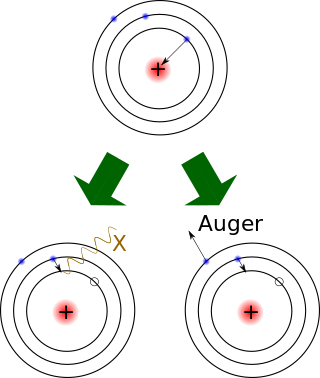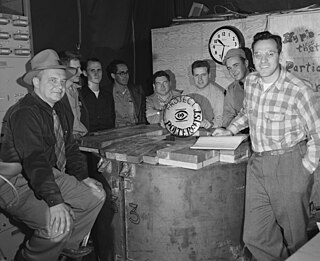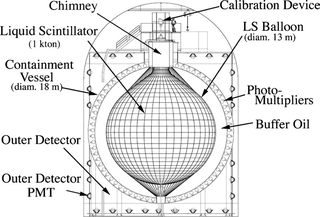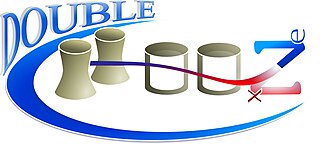
In nuclear physics, beta decay (β-decay) is a type of radioactive decay in which an atomic nucleus emits a beta particle, transforming into an isobar of that nuclide. For example, beta decay of a neutron transforms it into a proton by the emission of an electron accompanied by an antineutrino; or, conversely a proton is converted into a neutron by the emission of a positron with a neutrino in so-called positron emission. Neither the beta particle nor its associated (anti-)neutrino exist within the nucleus prior to beta decay, but are created in the decay process. By this process, unstable atoms obtain a more stable ratio of protons to neutrons. The probability of a nuclide decaying due to beta and other forms of decay is determined by its nuclear binding energy. The binding energies of all existing nuclides form what is called the nuclear band or valley of stability. For either electron or positron emission to be energetically possible, the energy release or Q value must be positive.

The neutron is a subatomic particle, symbol
n
or
n0
, which has a neutral charge, and a mass slightly greater than that of a proton. Protons and neutrons constitute the nuclei of atoms. Since protons and neutrons behave similarly within the nucleus, and each has a mass of approximately one dalton, they are both referred to as nucleons. Their properties and interactions are described by nuclear physics. Protons and neutrons are not elementary particles; each is composed of three quarks.

A neutrino is a fermion that interacts only via the weak interaction and gravity. The neutrino is so named because it is electrically neutral and because its rest mass is so small (-ino) that it was long thought to be zero. The rest mass of the neutrino is much smaller than that of the other known elementary particles. The weak force has a very short range, the gravitational interaction is extremely weak due to the very small mass of the neutrino, and neutrinos do not participate in the electromagnetic interaction or the strong interaction. Thus, neutrinos typically pass through normal matter unimpeded and undetected.

Electron capture is a process in which the proton-rich nucleus of an electrically neutral atom absorbs an inner atomic electron, usually from the K or L electron shells. This process thereby changes a nuclear proton to a neutron and simultaneously causes the emission of an electron neutrino.

Neutrino astronomy is the branch of astronomy that observes astronomical objects with neutrino detectors in special observatories. Neutrinos are created as a result of certain types of radioactive decay, nuclear reactions such as those that take place in the Sun or high energy astrophysical phenomena, in nuclear reactors, or when cosmic rays hit atoms in the atmosphere. Neutrinos rarely interact with matter, meaning that it is unlikely for them to scatter along their trajectory, unlike photons. Therefore, neutrinos offer a unique opportunity to observe processes that are inaccessible to optical telescopes, such as reactions in the Sun's core. Neutrinos can also offer a very strong pointing direction compared to charged particle cosmic rays.

The Cowan–Reines neutrino experiment was conducted by physicists Clyde Cowan and Frederick Reines in 1956. The experiment confirmed the existence of neutrinos. Neutrinos, subatomic particles with no electric charge and very small mass, had been conjectured to be an essential particle in beta decay processes in the 1930s. With neither mass nor charge, such particles appeared to be impossible to detect. The experiment exploited a huge flux of electron antineutrinos emanating from a nearby nuclear reactor and a detector consisting of large tanks of water. Neutrino interactions with the protons of the water were observed, verifying the existence and basic properties of this particle for the first time.
In particle physics, lepton number is a conserved quantum number representing the difference between the number of leptons and the number of antileptons in an elementary particle reaction. Lepton number is an additive quantum number, so its sum is preserved in interactions. The lepton number is defined by

A solar neutrino is a neutrino originating from nuclear fusion in the Sun's core, and is the most common type of neutrino passing through any source observed on Earth at any particular moment. Neutrinos are elementary particles with extremely small rest mass and a neutral electric charge. They only interact with matter via the weak interaction and gravity, making their detection very difficult. This has led to the now-resolved solar neutrino problem. Much is now known about solar neutrinos, but the research in this field is ongoing.

In nuclear physics, double beta decay is a type of radioactive decay in which two neutrons are simultaneously transformed into two protons, or vice versa, inside an atomic nucleus. As in single beta decay, this process allows the atom to move closer to the optimal ratio of protons and neutrons. As a result of this transformation, the nucleus emits two detectable beta particles, which are electrons or positrons.

The Kamioka Liquid Scintillator Antineutrino Detector (KamLAND) is an electron antineutrino detector at the Kamioka Observatory, an underground neutrino detection facility in Hida, Gifu, Japan. The device is situated in a drift mine shaft in the old KamiokaNDE cavity in the Japanese Alps. The site is surrounded by 53 Japanese commercial nuclear reactors. Nuclear reactors produce electron antineutrinos () during the decay of radioactive fission products in the nuclear fuel. Like the intensity of light from a light bulb or a distant star, the isotropically-emitted flux decreases at 1/R2 per increasing distance R from the reactor. The device is sensitive up to an estimated 25% of antineutrinos from nuclear reactors that exceed the threshold energy of 1.8 megaelectronvolts (MeV) and thus produces a signal in the detector.

A neutrino detector is a physics apparatus which is designed to study neutrinos. Because neutrinos only weakly interact with other particles of matter, neutrino detectors must be very large to detect a significant number of neutrinos. Neutrino detectors are often built underground, to isolate the detector from cosmic rays and other background radiation. The field of neutrino astronomy is still very much in its infancy – the only confirmed extraterrestrial sources as of 2018 are the Sun and the supernova 1987A in the nearby Large Magellanic Cloud. Another likely source is the blazar TXS 0506+056 about 3.7 billion light years away. Neutrino observatories will "give astronomers fresh eyes with which to study the universe".
T2K is a particle physics experiment studying the oscillations of the accelerator neutrinos. The experiment is conducted in Japan by the international cooperation of about 500 physicists and engineers with over 60 research institutions from several countries from Europe, Asia and North America and it is a recognized CERN experiment (RE13). T2K collected data within its first phase of operation from 2010 till 2021. The second phase of data taking (T2K-II) is expected to start in 2023 and last until commencement of the successor of T2K – the Hyper-Kamiokande experiment in 2027.
Chooz (French:[ʃo]) was a short baseline neutrino oscillation experiment in Chooz, France. Its major result was setting limits on the neutrino oscillation parameters responsible for changing electron neutrinos into other neutrinos. Specifically, it found that sin2(2θ13) < 0.17 for large δm2 and δm2 > 8×10−4 eV2 for maximal mixing. The results were published in 1999.

Borexino is a deep underground particle physics experiment to study low energy (sub-MeV) solar neutrinos. The detector is the world's most radio-pure liquid scintillator calorimeter and is protected by 3,800 meters of water-equivalent depth. The scintillator is pseudocumene and PPO which is held in place by a thin nylon sphere. It is placed within a stainless steel sphere which holds the photomultiplier tubes (PMTs) used as signal detectors and is shielded by a water tank to protect it against external radiation. Outward pointing PMT's look for any outward facing light flashes to tag incoming cosmic muons that manage to penetrate the overburden of the mountain above. Neutrino energy can be determined through the number of photoelectrons measured in the PMT's. While the position can be determined by extrapolating the difference in arrival times of photons at PMT's throughout the chamber.

Double Chooz was a short-baseline neutrino oscillation experiment in Chooz, France. Its goal was to measure or set a limit on the θ13 mixing angle, a neutrino oscillation parameter responsible for changing electron neutrinos into other neutrinos. The experiment uses reactors of the Chooz Nuclear Power Plant as a neutrino source and measures the flux of neutrinos they receive. To accomplish this, Double Chooz has a set of two detectors situated 400 meters and 1050 meters from the reactors. Double Chooz was a successor to the Chooz experiment; one of its detectors occupies the same site as its predecessor. Until January 2015 all data has been collected using only the far detector. The near detector was completed in September 2014, after construction delays, and started taking data at the beginning of 2015. Both detectors stopped taking data in late December 2017.
A geoneutrino is a neutrino or antineutrino emitted in decay of radionuclide naturally occurring in the Earth. Neutrinos, the lightest of the known subatomic particles, lack measurable electromagnetic properties and interact only via the weak nuclear force when ignoring gravity. Matter is virtually transparent to neutrinos and consequently they travel, unimpeded, at near light speed through the Earth from their point of emission. Collectively, geoneutrinos carry integrated information about the abundances of their radioactive sources inside the Earth. A major objective of the emerging field of neutrino geophysics involves extracting geologically useful information from geoneutrino measurements. Analysts from the Borexino collaboration have been able to get to 53 events of neutrinos originating from the interior of the Earth.

When embedded in an atomic nucleus, neutrons are (usually) stable particles. Outside the nucleus, free neutrons are unstable and have a mean lifetime of 877.75+0.50
−0.44 s or 879.6±0.8 s. Therefore, the half-life for this process is 611±1 s.
The diffuse supernova neutrino background(DSNB) is a theoretical population of neutrinos (and anti-neutrinos) cumulatively originating from all core-collapse supernovae events throughout the history of the universe. Though it has not yet been directly detected, the DSNB is theorized to be isotropic and consists of neutrinos with typical energies on the scale of 107 eV. Current detection efforts are limited by the influence of background noise in the search for DSNB neutrinos and are therefore limited to placing limits on the parameters of the DSNB, namely the neutrino flux. Restrictions on these parameters have gotten more strict in recent years, but many researchers are looking to make direct observations in the near future with next generation detectors. The DSNB is not to be confused with the cosmic neutrino background (CNB), which is comprised by relic neutrinos that were produced during the Big Bang and have much lower energies (10−4 to 10−6 eV).
The STEREO experiment investigates the possible oscillation of neutrinos from a nuclear reactor into light so-called sterile neutrinos. It is located at the Institut Laue–Langevin (ILL) in Grenoble, France. The experiment started operating and taking data in November 2016.
Supernova neutrinos are weakly interactive elementary particles produced during a core-collapse supernova explosion. A massive star collapses at the end of its life, emitting on the order of 1058 neutrinos and antineutrinos in all lepton flavors. The luminosity of different neutrino and antineutrino species are roughly the same. They carry away about 99% of the gravitational energy of the dying star as a burst lasting tens of seconds. The typical supernova neutrino energies are 10 to 20 MeV. Supernovae are considered the strongest and most frequent source of cosmic neutrinos in the MeV energy range.












